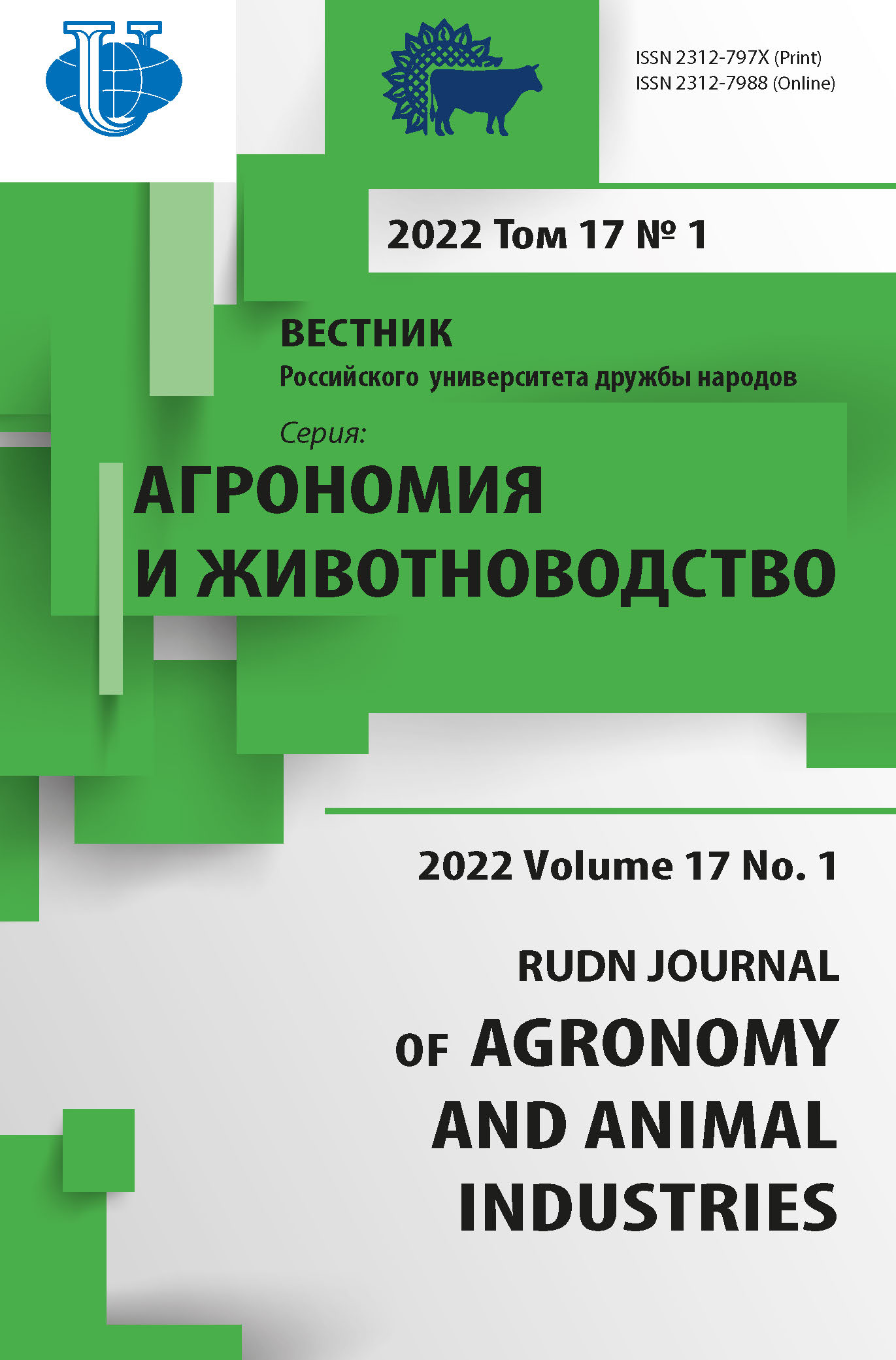Efficiency of meat-fattening rabbits farmed by different keeping technologies
- Authors: Kvartnikova E.G.1, Shastina E.V.2
-
Affiliations:
- Research Institute of Fur-farming and rabbit breeding named after V.A. Afanasyev
- Kostroma Agricultural Academy
- Issue: Vol 17, No 1 (2022)
- Pages: 104-111
- Section: Animal breeding
- URL: https://journal-vniispk.ru/2312-797X/article/view/315654
- DOI: https://doi.org/10.22363/2312-797X-2022-17-1-104-111
- ID: 315654
Cite item
Full Text
Abstract
In Russia, different technologies are used for keeping commercial young animals in the production of rabbit meat. The main ones are in rooms with a controlled microclimate (imported young rabbits) and sheds (domestic breeds). The aim of the study was to establish the dominant factors that determine efficiency of rabbit meat production under different keeping technologies and dry feeding. Experimental studies were conducted according to classical zootechnical methods. The experiment in the room with controlled conditions was carried out on crossbred young animals - f rom Californian and New Zealand white breeds, which were imported from France in 2010; the experiment on domestic breed - Soviet chinchilla - was carried out under shed keeping technology. During the fattening period all rabbits were fed with complete granulated compound feed with an identical ratio of nutrients: 16.0 % protein and 17.5 % fiber for crossbred rabbits; 16.4 % protein and 17.9 % fiber for Soviet chinchilla rabbits. Slaughter of Soviet chinchilla rabbits and crossbred rabbits for meat was carried out at the age of 90 and 77 days, respectively. Analysis of the dynamics of live weight showed that at the age of 45 days and at the time of slaughter crossbred young rabbits exceeded Soviet chinchilla rabbits by 204.5 g and 240.0 g, respectively. Meanwhile, the relative growth of crossbred rabbits was not much higher than this indicator in Soviet chinchilla rabbits (by 3.4 and 4.1 %, respectively). The pre-slaughter weight was also significantly higher in crossbred animals, and the carcass weight was significantly higher in Soviet chinchilla rabbits. Accordingly, in the Soviet chinchilla the slaughter yield was 9.2 % higher than that of the crossbred rabbits, that is in meat production in the Soviet chinchilla more organic matter goes into products and less to waste. This testifies to the fact that by the age of 77 days the crossbred rabbits did not realize their full meat potential. Thus, considering the increased energy costs in buildings with a controlled microclimate, both technologies for keeping commercial young rabbits have the same chances in the production of rabbit meat.
About the authors
Elizaveta G. Kvartnikova
Research Institute of Fur-farming and rabbit breeding named after V.A. Afanasyev
Email: liza.kvartnikova@mail.ru
ORCID iD: 0000-0002-5009-0353
Doctor of Agricultural Sciences, Professor, Chief Researcher, Department of Fur Farming and Rabbit Breeding
6 Trudovaya st., Rodniki vil., Ramensky district, Moscow region, 140143, Russian FederationElena V. Shastina
Kostroma Agricultural Academy
Author for correspondence.
Email: beoglu.e@mail.ru
ORCID iD: 0000-0002-6134-403X
Candidate of Agricultural Sciences, Senior professor, Department of Animal Anatomy and Physiology
34 Uchebnyy gorodok st., Karavaevo vil., Kostroma district, Kostroma region, 156530, Russian FederationReferences
- Ahmed MK, Bargue AR, Nawaz H, Siddiqui RH. Effect of varying energy and protein levels of the haematology of Japanese quail. Pakistan Vet. Journal. 1994; 14(4):200—202.
- Cervera C, Fernández Carmona JF. Nutrition and the climatic environment. In: De Blas C, Wiseman J. (eds.) Nutrition of the Rabbit. 2nd ed. Wallingford, UK: CABI Publishing; 2010. p.267—284.
- De Blas C, Wiseman J. (eds.) Nutrition of the rabbit. 2nd ed. Wallingford, UK: CABI Publishing; 2010.
- Tazzoli M, Trocino A, Birolo M, Radaelli G, Xiccato G. Optimizing feed efficiency and nitrogen excretion in growing rabbits by increasing dietary energy with high-starch, high-soluble fibre, low-insoluble fibre supply at low protein levels. Livestock Science. 2015; 172:59—68. doi: 10.1016/j.livsci.2014.12.006
- Komlatsky VI, Zyganok LE, Turkova VS. The development of industrial rabbit breeding in the Kuban region. Krolikovodstvo i zverovodstvo. 2019; (5):8—16. (In Russ). doi: 10.24418/KIPZ.2019.5.0002
- Komlatsky GV, Turkova VS. The socio-economic efficiency of industrial rabbit breeding. Krolikovodstvo i zverovodstvo. 2020; (6):39—50. (In Russ). doi: 10.24411/0023–4885–2020–00034
- Balakirev NA, Kalugin YA. Rabbit breeding — a promising livestock industry. Veterinariya, zootekhniya i biotekhnologiya. 2015; (7):20—23. (In Russ).
- Velkina LV. Global trends in development of rabbit breeding. Economics of Agriculture in Russia. 2019; (3):93—98. (In Russ). doi: 10.32651/193–93.
- Klimova NV, Mozhegova VD. The effectiveness of investment in the development of rabbit business. Polythematic online scientific journal of Kuban state agrarian university. 2017; (125):500—509. (In Russ). doi: 10.21515/1990–4665–125–034
- Plotnikov VG. Trends in the development of rabbit breeding in the world. Krolikovodstvo i zverovodstvo. 2003; (2):13—16. (In Russ).
- Noreiko AY. Improving the efficiency of meat rabbit breeding in the conditions of a shedding system of maintenance. Vestnik Bryansk state agricultural academy. 2015; (3–2):38—41. (In Russ).
- Tinaev NI. Crossing — a cost-free method of increasing the productivity of rabbits on commodity farms. Krolikovodstvo i zverovodstvo. 2013; (1):14—17. (In Russ).
- Ratoshny AN, Chernenko EN, Chernenko AV. Use of different feeding systems for growing rabbits. Proceedings of the Kuban State Agrarian University. 2013; 2(2):151—155. (In Russ).
- Plotnikov VG. Evolution of technologies in rabbit farming. Krolikovodstvo i zverovodstvo. 2010; (1):17—22. (In Russ).
- Kvartnikova EG, Kosovsky GY, Kvartnikov MP. Meat productivity of rabbits with dry type of feeding. Rabbit breeding and fur farming. 2020; (4):34—39. (In Russ). doi: 10.24411/0023–4885–2020–10405
Supplementary files










